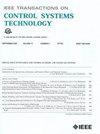Quasiperiodic Disturbance Observer for Wideband Harmonic Suppression
IF 3.9
2区 计算机科学
Q1 AUTOMATION & CONTROL SYSTEMS
引用次数: 0
Abstract
Periodic disturbances composed of harmonics typically occur during periodic operations, impairing the performance of mechanical and electrical systems. To improve the performance, control of periodic-disturbance suppression has been studied, such as repetitive control and periodic-disturbance observers. However, actual periodic disturbances are typically quasiperiodic owing to perturbations in each cycle, identification errors of the period, variations in the period, and/or aperiodic disturbances. For robustness against quasiperiodicity, although wideband harmonic suppression is expected, conventional methods have tradeoffs among harmonic suppression bandwidth, amplification of aperiodic disturbances, and deviation of harmonic suppression frequencies. This article proposes a quasiperiodic disturbance observer (QDOB) to compensate for quasiperiodic disturbances while simultaneously achieving the wideband harmonic suppression, nonamplification of aperiodic disturbances, and proper harmonic suppression frequencies. A quasiperiodic disturbance is defined as comprising harmonics and surrounding signals. On the basis of this definition, the QDOB is designed using a periodic-pass filter of a first-order periodic/aperiodic separation filter for its Q-filter, time delay integrated with a zero-phase low-pass filter, and an inverse plant model with a first-order low-pass filter. The periodic-pass filter achieves the wideband harmonic suppression while the zero-phase and first-order low-pass filters prevent the amplification of aperiodic disturbances and deviation of harmonic suppression frequencies. For the implementation, the Q-filter is discretized by an exact mapping of the s-plane to the z-plane, and the inverse plant model is discretized by the backward Euler method. The experiments validated the frequency response and position-control precision of the QDOB while comparing it with conventional methods.宽带谐波抑制的准周期扰动观测器
由谐波组成的周期性扰动通常发生在周期性运行期间,损害机械和电气系统的性能。为了提高系统的性能,研究了周期扰动抑制的控制方法,如重复控制和周期扰动观测器。然而,由于每个周期的扰动、周期的识别误差、周期的变化和/或非周期扰动,实际的周期扰动通常是准周期的。对于准周期性的鲁棒性,尽管期望宽带谐波抑制,但传统方法需要在谐波抑制带宽、非周期干扰放大和谐波抑制频率偏差之间进行权衡。本文提出了一种准周期干扰观测器(QDOB)来补偿准周期干扰,同时实现宽带谐波抑制、非周期干扰的非放大和适当的谐波抑制频率。准周期扰动定义为包含谐波和周围信号。在此定义的基础上,QDOB的q滤波器采用一阶周期/非周期分离滤波器的周期通滤波器、零相位低通滤波器集成的时延以及一阶低通滤波器的逆植物模型进行设计。周期通滤波器实现了宽带谐波抑制,零相滤波器和一阶低通滤波器防止了非周期干扰的放大和谐波抑制频率的偏离。在实现中,q -滤波器通过s平面到z平面的精确映射进行离散化,逆植物模型通过反向欧拉方法进行离散化。实验验证了QDOB的频率响应和位置控制精度,并与传统方法进行了比较。
本文章由计算机程序翻译,如有差异,请以英文原文为准。
求助全文
约1分钟内获得全文
求助全文
来源期刊

IEEE Transactions on Control Systems Technology
工程技术-工程:电子与电气
CiteScore
10.70
自引率
2.10%
发文量
218
审稿时长
6.7 months
期刊介绍:
The IEEE Transactions on Control Systems Technology publishes high quality technical papers on technological advances in control engineering. The word technology is from the Greek technologia. The modern meaning is a scientific method to achieve a practical purpose. Control Systems Technology includes all aspects of control engineering needed to implement practical control systems, from analysis and design, through simulation and hardware. A primary purpose of the IEEE Transactions on Control Systems Technology is to have an archival publication which will bridge the gap between theory and practice. Papers are published in the IEEE Transactions on Control System Technology which disclose significant new knowledge, exploratory developments, or practical applications in all aspects of technology needed to implement control systems, from analysis and design through simulation, and hardware.
 求助内容:
求助内容: 应助结果提醒方式:
应助结果提醒方式:


